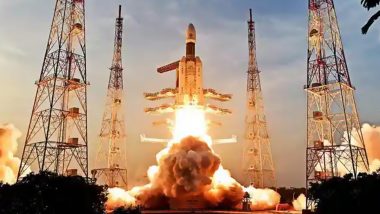New Delhi, September 15: India's maiden human space-flight mission 'Gaganyaan' is expected to be launched in 2024, Union Minister of State (Independent Charge) for Science and Technology, Jitendra Singh said. Earlier, the mission was scheduled to be launched in 2022 but that could not be achieved due to Covid-19. "The Covid-19 pandemic took a toll on the training of astronauts in Russia as well as India," Singh added as was quoted by an Indian news agency.
The first test-flight will be followed by sending a female-looking spacefaring humanoid robot -- VyomMitra -- in outer space likely next year. The Indian Air Force had identified four fighter pilots as the potential crew for the human space flight mission. The potential crew had undergone basic training in Russia.
The Indian Space Research Organisation (ISRO) will send at least two astronauts into a low earth orbit (LEO) in 2024 after assessing the outcome of the two orbital test flights. First Trial for Gaganyaan Will Be Done by the End of 2023.
According to ISRO, the Gaganyaan programme envisages undertaking the demonstration of human spaceflight to LEO in the short-term and will lay the foundation for a sustained Indian human space exploration programme in the long run.
The objective of this space programme is to demonstrate indigenous capability to undertake human space flight mission to LEO. As part of this programme, two unmanned missions and one manned mission are approved by the Indian government. The total cost of Gaganyaan programme would be to the tune of Rs 9,023 crore.
The Human spaceflight programme has both tangible and intangible benefits for India, which includes progress towards a sustained and affordable human and robotic programme to explore the solar system and beyond; advanced technology capability for undertaking human space exploration, sample return missions and scientific exploration and future capability to actively collaborate in global space station development and to carry out scientific experiments of interest to the nation.
It will also create a broad framework for wider academia -- industry partnership in taking up development activities for national development. It will generate ample scope for employment generation and human resource development in advanced science and R&D activities.
The mission will provide unique opportunity to inspire and excite Indian youth and steer many students toward careers in science and technology towards challenging jobs that encourage knowledge, innovation and creativity.
The programme will strengthen international partnerships and global security through the sharing of challenging and peaceful goals. Having a vibrant human spaceflight programme can be leveraged as a potent foreign policy tool.
According to ISRO, the uncrewed missions are for technology demonstration, safety and reliability verification and will be heavily instrumented to study the performance of systems before crewed flight.
The major new technologies required for Gaganyaan programme are -- human rated launch vehicle, crew escape systems, habitable orbital module, life support system and crew selection, and training and associated crew management activities.
Officials said during the test mission, the spacecraft will be launched to an altitude of 15 km during which space scientists will simulate an abort scenario to ensure the return crew capsule to the Earth using parachutes. The second orbital test flight will take the Gaganyaan crew capsule to a higher altitude and undergo a similar abort scenario to perfect the system.
The Gaganyaan programme is going to be a major national effort for India. The overall programme co-ordination, systems engineering and implementation will be carried out by ISRO.
Further, the human rated launch vehicle, crew escape system, orbital module and essential infrastructure will be realised by ISRO utilising the in-house expertise and with participation of industry, academia and national agencies. The private players in the country have developed significant expertise in niche areas, and this will be effectively utilised in the programme.
For the first crewed mission of Gaganyaan programme, astronaut trainees are selected from pool of test pilots, based on selection criterion jointly defined by ISRO and Indian Air Force which comprises of flying experience, fitness, psychological and aeromedical evaluation (including anthropometric parameters). Jitendra Singh C.alls for Linking StartUps with Industry Right from Beginning as Equal Stakeholders
After the successful completion of Gaganyaan programme, the next step will focus towards achieving capability for a sustained human presence in space. The ISRO also plans to launch the Chandrayaan-3 mission to the moon sometime in 2023. Officials said there were two launch windows for the moon mission in February and July 2023.
(The above story first appeared on LatestLY on Sep 15, 2022 09:51 AM IST. For more news and updates on politics, world, sports, entertainment and lifestyle, log on to our website latestly.com).













 Quickly
Quickly


